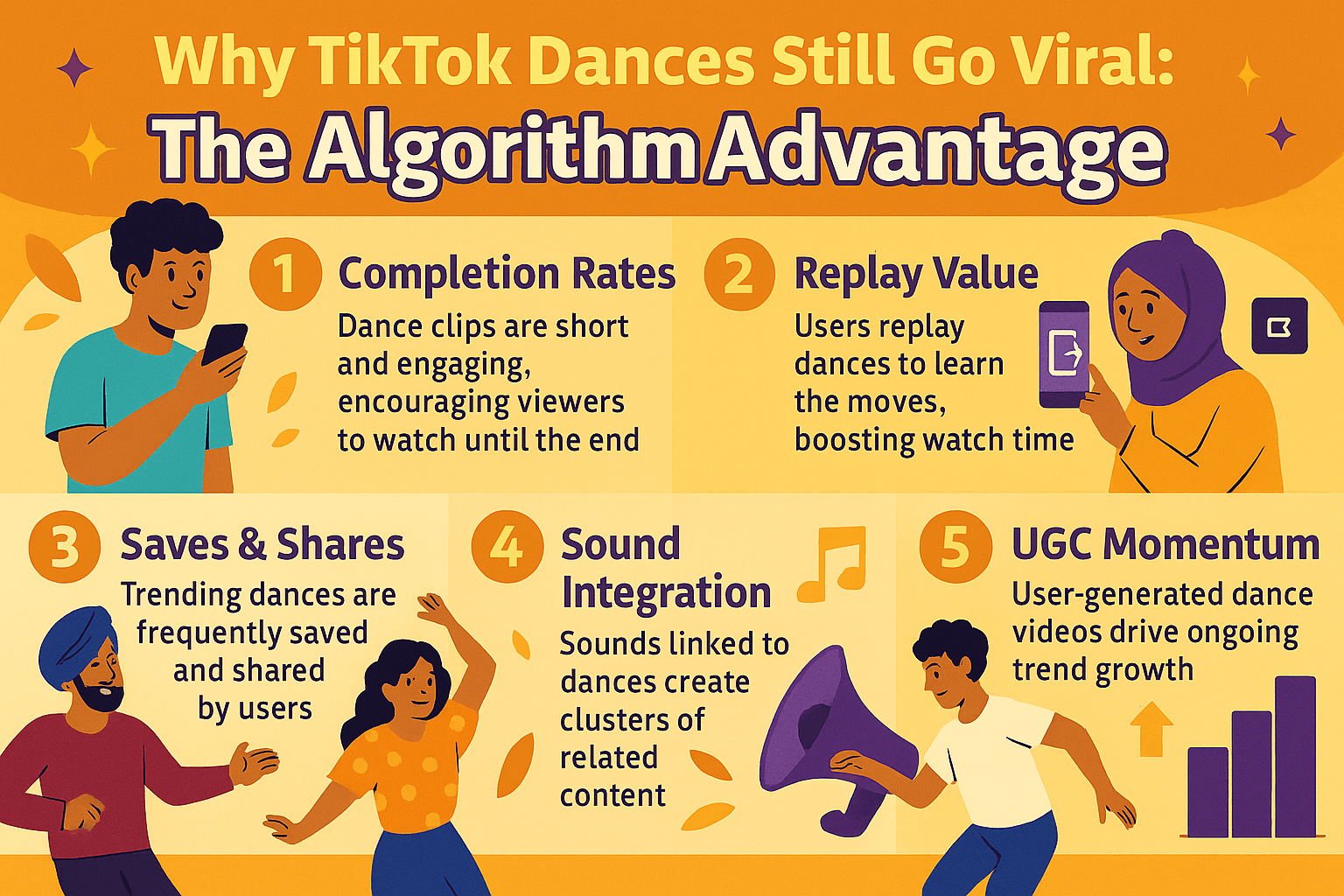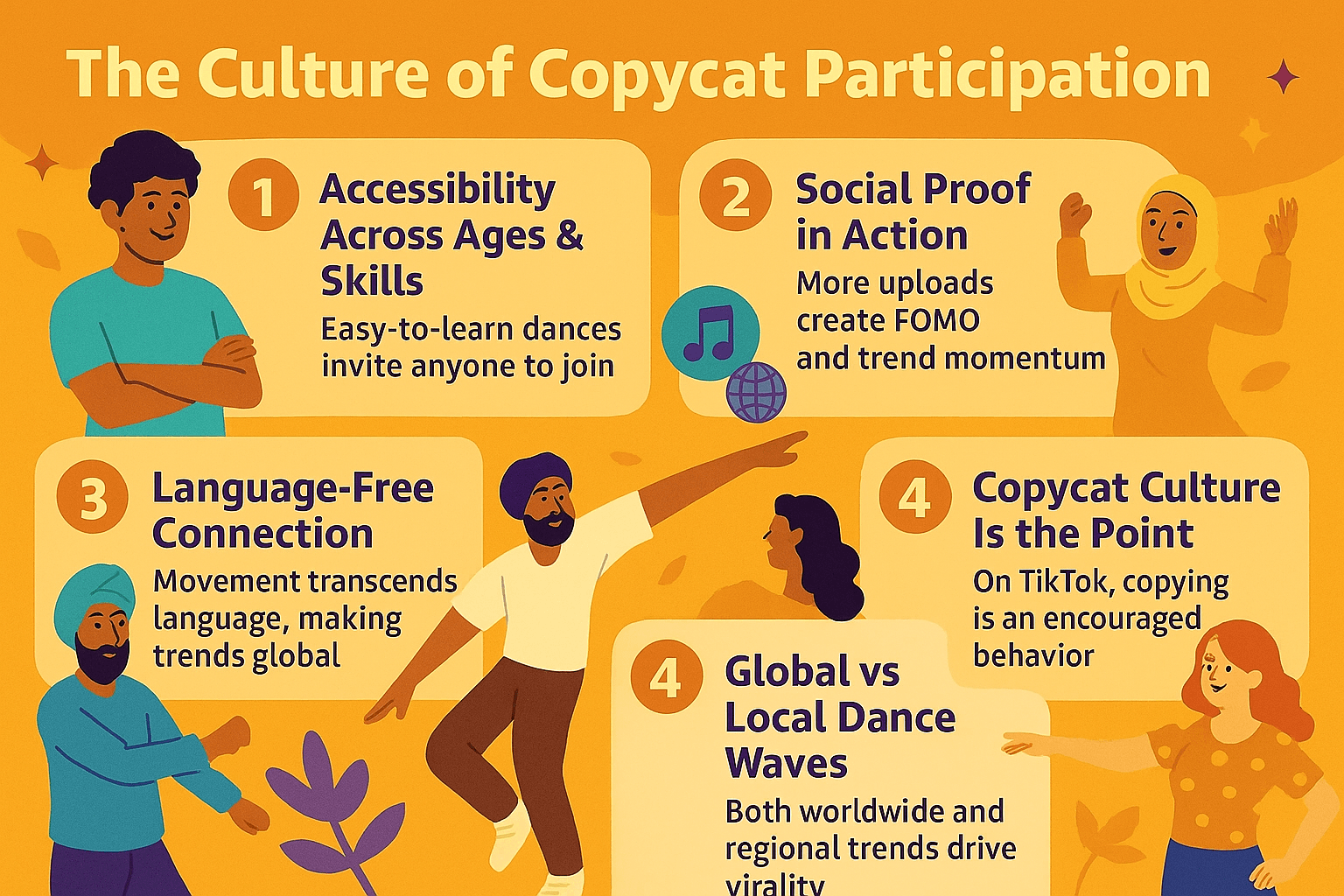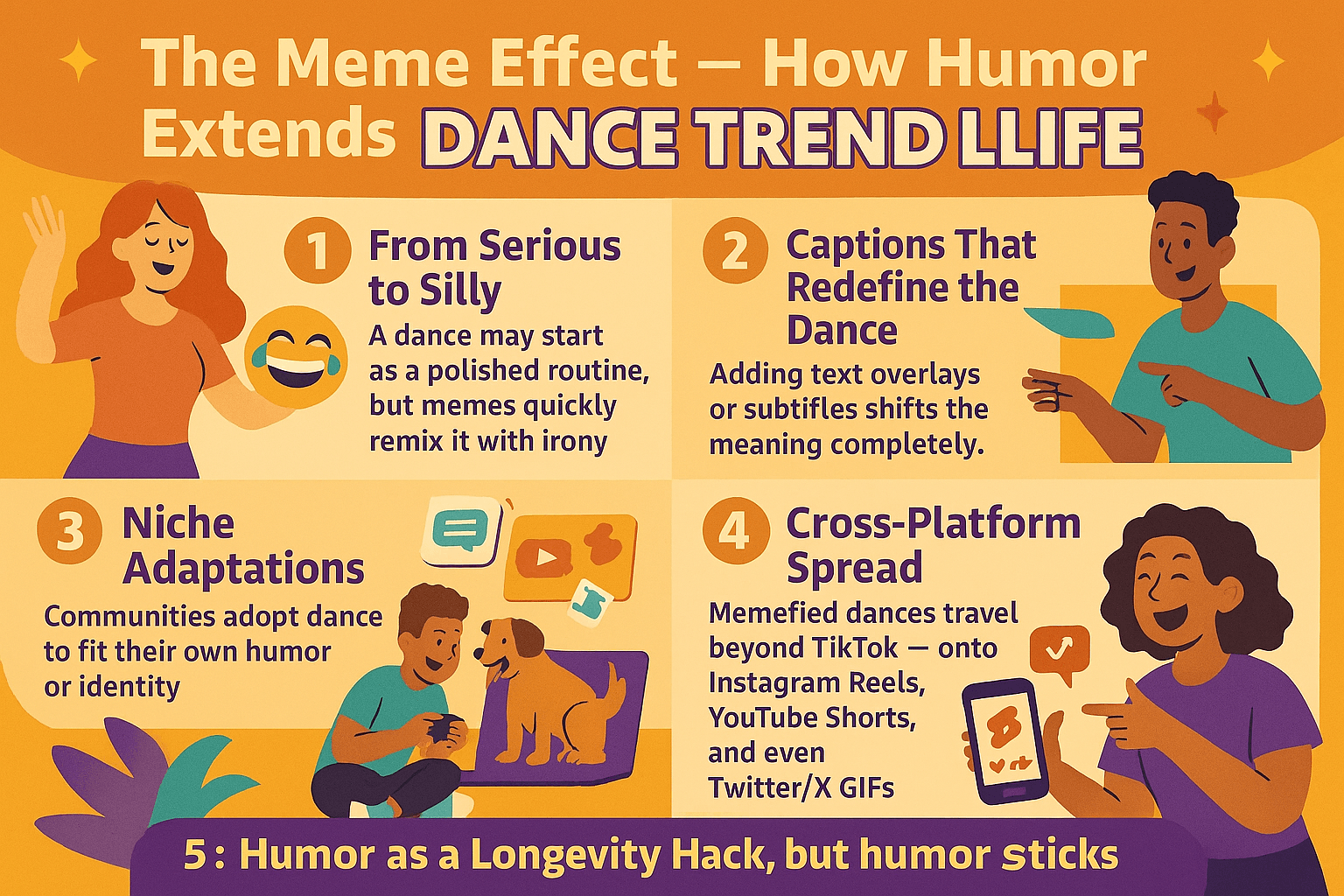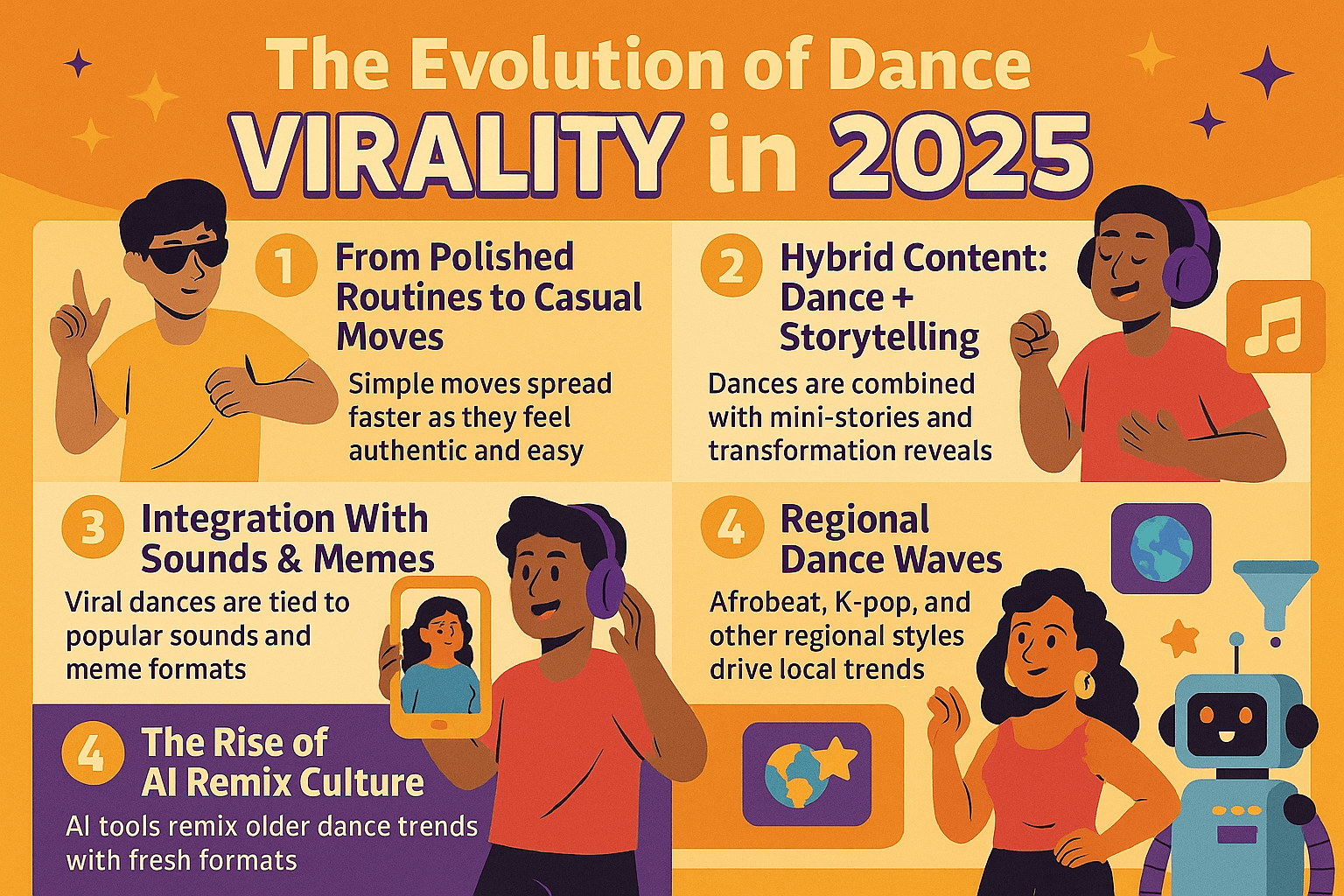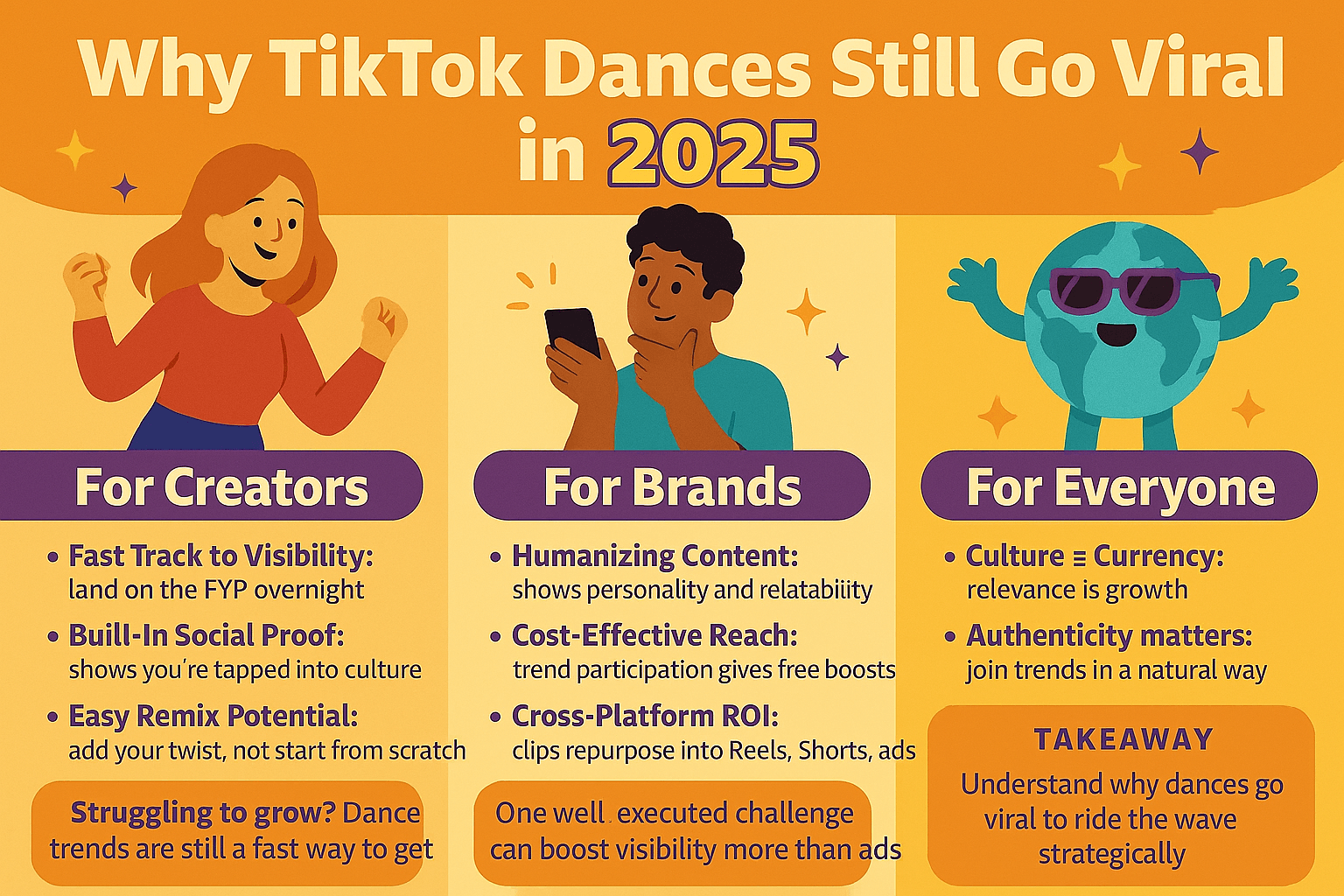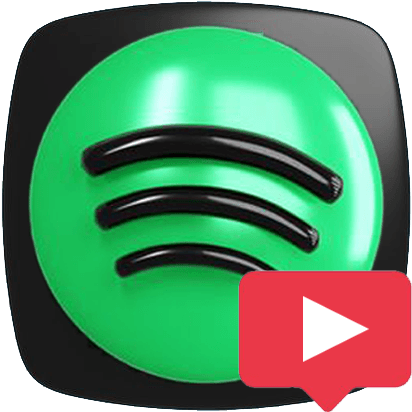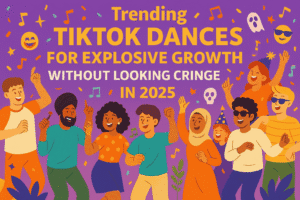The Algorithm Advantage
TikTok’s For You Page isn’t random — it’s powered by an algorithm that relentlessly prioritizes content designed to keep people watching, rewatching, and sharing. And that’s exactly why dance challenges still thrive in 2025.
Completion Rates
- TikTok favors videos that viewers watch all the way through.
- Dance clips are short, predictable, and often end with a satisfying payoff (like a final pose or beat drop).
- This makes them more likely to be completed compared to long skits or product demos.
Takeaway: The algorithm rewards dances because viewers rarely swipe away before the end.
Replay Value
- Many users replay dances to learn the moves, boosting watch time.
- Each replay signals to TikTok that the content is valuable and engaging.
- Even a 10–15 second loop can rack up minutes of watch time per user.
Takeaway: Dances naturally create repeat views, a top growth signal for TikTok.
Saves & Shares
- Trending dances are saved for later practice and shared in group chats.
- Saves and shares act as long-term traffic generators, keeping a dance alive weeks past its peak.
- A dance with high save rates will often resurface even after fading.
Takeaway: Dances spread because people want to try them, not just watch them.
Sound Integration
- TikTok indexes videos by audio. When thousands use the same trending sound, the algorithm clusters them together on the FYP.
- Dances dominate these clusters because the sound is tied directly to movement.
- A strong beat drop synced with choreography makes the clip irresistible.
Takeaway: Sounds and dances amplify each other, multiplying algorithmic reach.
UGC Momentum
- Every new version of a dance is user-generated content that pushes the trend further.
- The algorithm sees massive participation as a sign of cultural momentum.
- More uploads = more FYP placements → snowball effect.
Takeaway: The algorithm amplifies what the community is already replicating.
Dance trends succeed on TikTok not because they’re special — but because they’re perfectly aligned with how the platform measures engagement. Completion, replays, saves, shares, and sound clustering all work in their favor, making them the easiest type of content to go viral.
The Culture of Copycat Participation
TikTok isn’t just about watching — it’s about joining in. Dance trends thrive because the platform has built a culture where copying is celebrated, not shamed. Unlike other social platforms where originality is king, TikTok’s biggest cultural driver is participation through replication.
Accessibility Across Ages & Skills
- Dances are designed to be easy to learn, with only a few signature moves.
- This makes them accessible to everyone — kids, parents, professionals, even grandparents.
- Unlike pro-level choreography on YouTube, TikTok dances invite participation from people with zero dance background.
Takeaway: Accessibility ensures mass adoption, fueling virality.
Language-Free Connection
- Dance is universal — no need to understand English, Spanish, Japanese, or slang to join.
- Global users can instantly participate in the same trend without translation barriers.
- This makes dances ideal for worldwide virality compared to memes that depend on words.
Takeaway: Movement transcends language, making dances borderless.
Social Proof in Action
- Seeing thousands of people join a challenge creates FOMO (fear of missing out).
- Each new upload acts as social proof that the trend is worth joining.
- The more creators participate, the more the algorithm amplifies it.
Takeaway: Participation snowballs because nobody wants to feel left out.
Global vs Local Dance Waves
- Some dances become global phenomena (like Renegade in 2020).
- Others spread locally — like K-pop-inspired routines dominating in Asia or Afrobeat-influenced steps trending in Africa.
- This layered effect allows TikTok to host multiple viral dance waves at once.
Takeaway: Dance virality is multi-layered — a global stage with local rhythms.
Copycat Culture Is the Point
- On TikTok, copying isn’t stealing — it’s the expected behavior.
- The culture rewards imitation with personal twists (outfits, props, settings).
- Each copy makes the trend stronger, extending its viral lifespan.
Takeaway: TikTok flips the script: replication = validation, not plagiarism.
Dance virality in 2025 is fueled by a culture where anyone can join, language doesn’t matter, and imitation is celebrated. This copycat participation creates a ripple effect that turns even the simplest choreography into a global wave.
Psychological Triggers That Make Dances Viral
TikTok dances don’t just work because of algorithms and culture — they also tap directly into human psychology. The way our brains process rhythm, repetition, and social signals makes dance challenges almost impossible to ignore. Here’s why:
Predictability + Payoff
- Most dances are built around a short loop with a clear ending (a pose, a clap, a beat drop).
- This predictability sets up a “mini story arc” that keeps viewers hooked until the end.
- The payoff moment (big move or beat sync) triggers satisfaction, similar to finishing a punchline in a joke.
Takeaway: The brain loves closure — and dance challenges deliver it in seconds.
Dopamine From Repetition
- When people replay dances to learn moves, the repetition creates a dopamine loop.
- The brain rewards progress (“I got the step right this time!”).
- Each replay not only trains muscle memory but also strengthens emotional attachment to the trend.
Takeaway: Repetition makes both the dance and the sound addictive.
Mirror Neurons in Action
- Watching someone dance activates mirror neurons, the same part of the brain that fires when we move ourselves.
- This makes viewers feel more involved, even if they never stand up to try the trend.
- It also nudges more people to copy, fueling the copycat culture.
Takeaway: Seeing a dance makes you want to dance — literally.
Identity & Relatability
- Dances become more viral when people add their own twist: outfits, props, facial expressions.
- Viewers connect because they see themselves in the performers — “That could be me.”
- This relatability makes trends more inclusive and long-lasting.
Takeaway: Viral dances spread because they feel personal, not polished.
Social Validation
- Posting a trending dance invites likes, comments, and duets.
- Every positive reaction reinforces the creator’s decision to participate.
- This validation loop motivates more people to try the trend, multiplying its reach.
Takeaway: Social validation turns a simple move into a viral snowball.
TikTok dances hijack our psychology: predictable payoffs, dopamine from repetition, mirror neuron activation, identity connection, and social validation. Together, these triggers explain why even the simplest choreography keeps spreading in 2025.
The Meme Effect — How Humor Extends Dance Trend Life
If choreography is the hook and sound is the glue, memes are the fuel that keep TikTok dances alive long after the initial wave. By adding humor, irony, or relatability, creators turn simple moves into cultural moments that spread across niches and platforms.
From Serious to Silly
- A dance may start as a polished routine, but memes quickly remix it with irony.
- Example: A confident strut re-captioned as “How I walk into work on Friday vs Monday.”
- This twist attracts viewers who might not care about the dance itself.
Takeaway: Memes broaden a dance trend’s appeal beyond dancers.
Captions That Redefine the Dance
- Adding text overlays or subtitles shifts the meaning completely.
- Example: A dramatic move captioned “Me waiting for Wi-Fi to reconnect.”
- These captions create new punchlines, turning the dance into a visual joke.
Takeaway: Words + moves = unlimited remix potential.
Niche Adaptations
- Communities adopt dances to fit their own humor or identity.
- Gamers, pet owners, students, and even corporate workers spin the same dance into new contexts.
- Each niche adaptation injects fresh life into the trend.
Takeaway: The more communities adopt a dance, the longer it survives.
Cross-Platform Spread
- Memefied dances travel beyond TikTok — onto Instagram Reels, YouTube Shorts, and even Twitter/X GIFs.
- Each platform reintroduces the trend to new audiences.
- A joke caption + short dance = the perfect format for shareability.
Takeaway: Memes transform TikTok dances into cross-platform content.
Humor as a Longevity Hack
- Pure choreography fades fast, but humor sticks.
- When people laugh, they replay, save, and share — all algorithm boosters.
- This makes memefied dances last weeks (sometimes months) longer than the original.
Takeaway: Humor isn’t just funny — it’s a growth engine.
Memes extend the life of TikTok dances by adding humor, relatability, and niche identity. They make trends accessible to wider audiences, adaptable to different communities, and portable across platforms. Without memes, a dance is just choreography. With memes, it’s culture in motion.
The Evolution of Dance Virality in 2025
TikTok’s dance culture hasn’t stood still. Since the early days of polished routines like the Renegade, dance virality has continuously reshaped itself to match the platform’s growth. In 2025, the way dances go viral looks different — and smarter — than it did just a few years ago.
From Polished Routines to Casual Moves
- Early viral dances looked like mini music videos with sharp choreography.
- Today, casual dances — a walk, a shrug, even a single gesture — spread faster because they feel authentic and easy.
- The algorithm now favors raw over polished, rewarding accessibility.
Takeaway: Simplicity has replaced complexity as the viral driver.
Hybrid Content: Dance + Storytelling
- Dances are now blended with mini-stories: outfit changes, before/after reveals, or comedic setups.
- This hybridization keeps dances fresh while appealing to non-dance audiences.
- Example: A transformation challenge that’s half dance, half glow-up story.
Takeaway: Dances now function as storytelling tools, not just choreography.
Integration With Sounds & Memes
- In 2025, no dance trend exists in isolation.
- Viral dances almost always link to a sound clip or meme format.
- A beat drop, a lyric, or a punchline transforms choreography into cultural shorthand.
Takeaway: Sound + meme integration is now a requirement for virality.
Regional Dance Waves
- Global TikTok means multiple viral waves at once.
- Afrobeat, K-pop, Latin, and local sounds drive region-specific dance trends.
- Some dances cross over globally, others remain massive within their cultural niche.
Takeaway: Virality is no longer universal — it’s layered by region.
The Rise of AI Remix Culture
- AI tools are now remixing old dance formats with new sounds, visuals, and captions.
- This creates “second life” waves for dances that might have died out.
- AI-assisted spinoffs ensure that even older challenges resurface with fresh relevance.
Takeaway: Technology is extending the shelf life of viral dances.
Dance virality in 2025 has evolved from polished choreography → casual authenticity → hybrid storytelling → cultural remixing with AI. This evolution keeps dances relevant in TikTok’s fast-changing ecosystem, proving why they’re still one of the platform’s most reliable growth engines.
Why This Matters for Creators & Brands
Understanding why TikTok dances still go viral isn’t just trivia — it’s a roadmap. The same forces that make a simple dance trend explode can also fuel your growth if you know how to align with them.
For Creators
- Fast Track to Visibility: Dances remain one of the few formats where new accounts can land on the FYP overnight.
- Built-In Social Proof: Participating in a popular dance shows viewers you’re tapped into the culture.
- Easy Remix Potential: You don’t need to invent from scratch — just add your twist (outfit, caption, location).
Takeaway: If you’re struggling to break through, dance trends are still one of the quickest ways to get seen in 2025.
For Brands
- Humanizing Content: Joining a dance trend shows your brand has personality and relatability.
- Cost-Effective Reach: No need for expensive campaigns — trend participation gives free algorithm boosts.
- Cross-Platform ROI: Dance clips easily repurpose into Instagram Reels, YouTube Shorts, and even ads.
Takeaway: For brands, a single well-executed dance challenge can create more visibility than weeks of traditional promotion.
For Everyone
- Culture = Currency: On TikTok, relevance is growth.
- Dances are still the clearest shortcut to staying visible in a noisy feed.
- But success comes from participation done authentically, not forced or gimmicky.
Takeaway: Whether you’re a solo creator or a global brand, understanding why dances go viral means you can ride the wave strategically — instead of missing it.
TikTok dances aren’t going away in 2025. They’re still viral because they’re algorithm-friendly, culturally inclusive, psychologically sticky, and meme-ready. For creators, they’re an entry point to growth. For brands, they’re a cultural bridge. Either way, the lesson is the same: join smart, adapt naturally, and let the trend work for you.
Conclusion
TikTok dances have proven their staying power. In 2025, they’re not just relics of TikTok’s past — they’re still one of the most effective ways to go viral. Why? Because they align perfectly with both technology and culture:
- Algorithm advantage: Completion rates, replays, saves, and sound integration.
- Cultural power: Copycat participation and global accessibility.
- Psychology at work: Predictability, dopamine, and social validation.
- Meme effect: Humor stretches a trend’s lifespan.
- Evolution in 2025: From polished choreography to hybrid storytelling and AI remixes.
- Relevance for all: Creators gain visibility, brands gain relatability.
The result: TikTok dances remain a shortcut to visibility and growth. But understanding why they work means you can join strategically, avoid forced participation, and ride the wave at the right time.
Ready to Grow With TikTok Dances?
Don’t let fleeting trends pass you by. Strengthen your foundation so every dance challenge you join has multiplied impact.
Boost Your TikTok Growth With Real Likes — and turn viral moments into lasting success.

